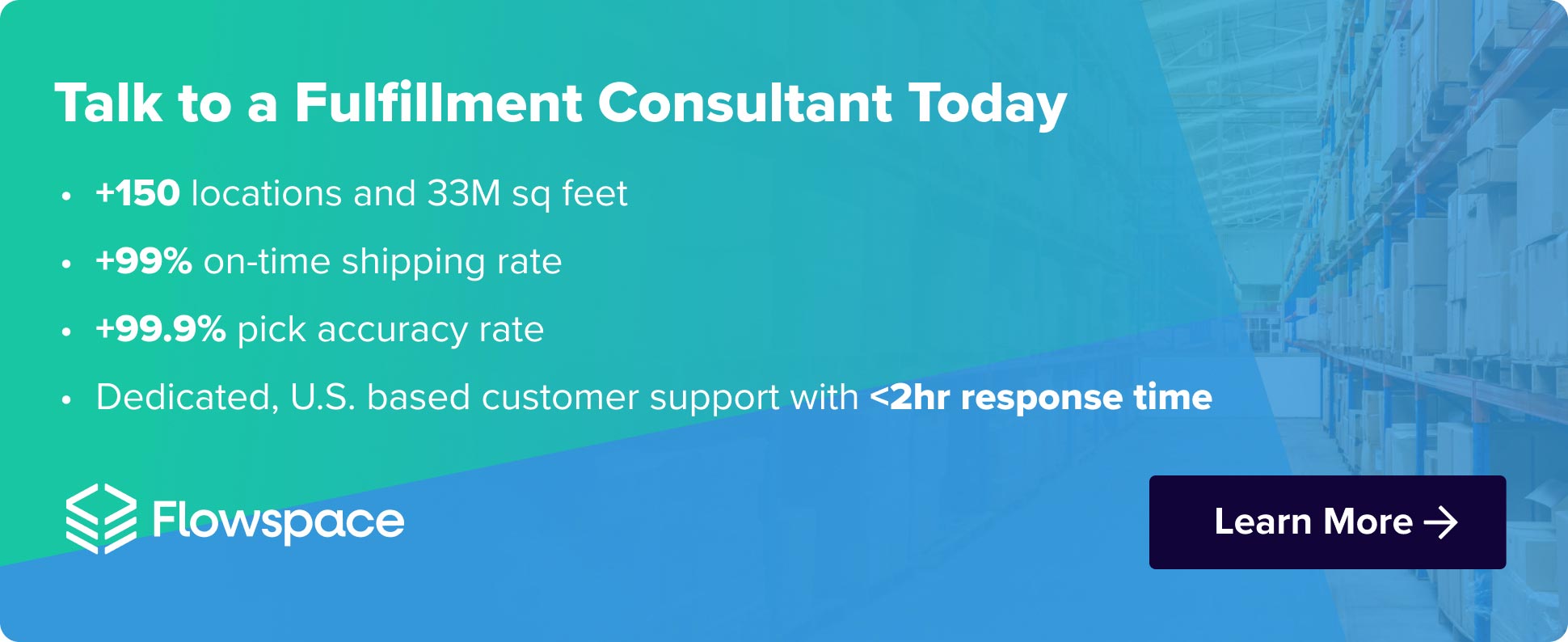Managing a brands’ logistics is a complex job, and if you’re in the food and beverage category, you’re contending with an added set of intricacies and challenges.
Food and beverage products are among the top selling ecommerce items, and as consumers increasingly shift their shopping online, brands need to ensure their fulfillment logistics capabilities are up to the task of getting products to customers quickly and efficiently, while also maintaining the quality and freshness of their products.
In this blog post, we will explore the top eight food and beverage supply chain challenges faced by food and beverage brands when it comes to fulfillment, and provide examples of the specialized solutions available to help overcome these obstacles so your business can thrive and scale.
To view our webinar offering behind the scenes secrets to excellence in food and beverage fulfillment, click here.
Challenges
It’s not news that the past few years have been challenging for the supply chain, and the impacts have been felt across the ecommerce industry. Here are eight of the top challenges facing the food and beverage supply chain.
Navigating SKU and Inventory Complexity
Imagine: You’ve successfully broadened your product line, and the market response is phenomenal. Your expanded brand is growing, but so is the complexity of managing a larger number of SKUs and the various ways they can be sold.
How do you decide on the best merchandising strategy? And how do you ensure that your products are always available to meet the demands of your eager customers?
As your brand continues to grow, it’s crucial to have a reliable partner who can help you navigate the complexities of SKU management and order fulfillment.
Brands need to ensure they have access to real-time insights and inventory tracking to stay up-to-date on inventory levels, account for excess stock and obsolete inventory during times of low demand, and know when to order more. A platform equipped with advanced reporting capabilities and comprehensive lot tracking is the key to maintaining complete control over your inventory.
Blind Spots in Inventory Visibility
Don’t let a stockout hinder your success.
Any merchant’s worst nightmare is to generate an incredible amount of interest, only to find themselves out of stock or otherwise unable to meet demand.
Imagine if one of your products suddenly becomes a sensation on TikTok, but you don’t have enough inventory to fill the influx of orders. Or suppose you’re set to replenish your most popular item in Target stores, only to discover you’re running low on that product.
To navigate the complexities of multiple sales channels, you need real-time visibility into your inventory across your entire fulfillment network.
From the moment a customer places an order, to the point of delivery, it’s crucial to have complete control and insight into your inventory at every stage. This not only helps you stay on top of customer demands but also enables your support team to proactively inform customers about order updates and alerts, reducing the chances of complaints and dissatisfaction.
Strategically Scaling from DTC to B2B
Running a successful e-commerce business is just the beginning for food and beverage brands. Once you make it onto the shelves of retail stores, a whole new set of challenges arise.
Now you have to navigate retailer regulations and ensure your fulfillment partners have the technical expertise to meet them, in order to avoid chargebacks at all costs.
To effectively compete in both DTC and wholesale markets, food and beverage brands need the right tools and expertise.
Don’t let the complexity of expansion hold you back. Take advantage of fulfillment partners that provide the technology and industry knowledge to streamline inventory control and order management, centralizing your DTC and retail logistics.
The Potential for Food Fraud
If any ingredient in a product is outsourced, there’s the potential for fraud in the food and beverage supply chain.
That doesn’t just mean substituting a different product, but also using undisclosed additives or enhancement, or contaminating food. Ensuring that there’s been no fraud at any point in the supply chain is important to ensure you are selling high-quality products to your customers.
The discovery of any foreign object or undeclared allergen (nuts, eggs, soy, etc.) can trigger a recall, the average cost of which is more than $10 million , according to a joint industry study by the Food Marketing Institute and the Grocery Manufacturers Association.
Effective Recall Management
Recalls happen. It’s an unfortunate but sometimes necessary occurrence within the food and beverage industry.
With the right tools and approach, you can effectively handle product recalls, and it all starts with accurate data and reporting.
To successfully manage a recall, you need to have a clear understanding of your inventory.
That’s why investing in fulfillment software with comprehensive lot-tracking capabilities and customizable picking strategies is crucial. These tools enables you to track your products throughout the supply chain and swiftly manage recalls if and when they occur.
Expanding Scope of Regulations
The food and beverage industry has a host of regulations to protect the public, which can often lead to increased costs for companies. For example, the ELD Mandate requires trucking companies to electronically log and monitor a truck driver’s daily hours. This has increased delays and shipping rates, which can impact fresh and perishable foods more than other products.
But there are also multiple state and federal laws requiring producers to provide a significant amount of information to the FDA prior to importation of food, including lot code numbers and other identifiers. For example, the Food Safety Modernization Act (FSMA), enacted in 2011, mandates comprehensive, science-based preventive controls across the food supply, requiring food facilities to implement written preventive controls plans. The FSMA also includes rules for food shippers to ensure safe practices during the transportation of human and animal food to prevent food safety risks.
The best way to avoid violating these laws is to maintain accurate labeling and lot tracking at every step of the supply chain.
Delays and Shortages
Many companies are reliant on raw materials and ingredients imported from other countries. And with the global supply chain ever in flux, factory closures and shipping delays can impact product availability.
This can mean big trouble for food and beverage brands, because perishable products generally have a shorter shelf life than other products.
Any significant disruption or delay could mean products have less time to be sold or—in the worst case scenario—are expired by the time they reach the customer.
Lack of Communication Between Supply Chain Partners
The global supply chain crisis has taught us that when multiple partners in multiple countries are involved in the supply chain, one delay or missed deadline from a distributor can throw off the entire system and cause painful supply chain bottlenecks.
The impact of these delays are even more disastrous for food and beverage companies that are dealing with products that can spoil.
Solutions
While the food and beverage supply chain faces some unique challenges, there are ways to overcome these so brands can future-proof their supply chain operations for whatever might come. We’ve outlined the top four solutions to supply chain issues in the food and beverage industry.
Move Products Closer to Consumers
Some brands store all their products in a singular warehouse and ship them to customers across the country from this one location. The farther a product has to travel, the more opportunity for delays and shipping issues that can mean that food product arrives at the customer’s door in less-than-perfect condition. This is especially important for food and beverage products that can be fragile or perishable—or both.
Today, smart brands are using order management software and connected networks of fulfillment centers to ensure that goods are stored and fulfilled closer to end consumers.
The flexible Flowspace network includes more than 150 fulfillment centers nationwide. And its proprietary Network Optimization algorithm will optimize your fulfillment network to determine which configuration of those locations will offer the most optimal efficiencies to a retailer ,based on its own data.
What’s more, Flowspace also has one of the largest networks of FDA-registered warehouses in the country, with dozens of locations capable of handling refrigeration and specialized packing instructions.
Ensure Compliant Product Labeling
It’s no secret that food and beverage brands are under more intense regulations when it comes to labeling. So how do you stay ahead of the regulations without disrupting or delaying orders?
Create a database that includes the characteristics, documentation, and final product specifications for each SKU so correct information can be pulled and included systematically.
Harness the Power of Predictive Analytics
There is such a thing as too much data. And with the skyrocketing popularity of food and beverage brands in ecommerce, you’ve likely got a lot of information to make sense of.
When harnessed, supply chain and fulfillment data can help maximize efficiencies across the business.
What you need is fulfillment software capable of turning insights into action, analyzing your data to help accurately determine customer demand. Armed with this information, you can plan ahead to ensure you have the right inventory, in the right quantities, at the right fulfillment locations, in order to best meet the needs of your end customers.
Not only do analytics tools help you plan smarter and avoid stockouts, but they also empower you to further refine your inventory forecasting, production, and purchasing strategies.
Unlock Real-Time Visibility
A real-time view into inventory, orders, and fulfillment activity helps you to stay ahead of fluctuations in demand. Real-time visibility is key for beverage and food supply chain resiliency—you’re better able to strike a balance between ensuring enough products are in stock to meet customers demands, without overstocking and risking expired inventory.
The best practice is to verify exactly where products have been, including all storage facilities, trucks, and fulfillment centers along the entire supply chain. Learn more about how to avoid overstocking and stockouts in our blog.
The Flowspace platform gives brands access to real-time inventory levels across all fulfillment centers in the Flowspace network. With a predictive view of remaining stock, brands are empowered to stay ahead of low inventory and replenishments.
Flowspace also offers full lot tracking and reporting capabilities in line with FDA and ISO regulations and certifications. This provides brands with real-time visibility into where items are stored and allows for immediate reporting on per-lot location and activity.
Lot tracking is especially important for perishable items, or inventory with expiration or best-by dates. In the event of an audit or recall, lot tracking enables brands to respond rapidly. If a brand needs to prioritize the shipment of specific product batches, lot tracking makes that possible.
Food and Beverage Fulfillment with Flowspace
Flowspace offers comprehensive fulfillment services tailored to meet the food and beverage industry.
Our distributed and configurable network, one of the largest FDA-registered warehouse networks in the country, is adept at handling the unique challenges of food and beverage distribution.
Learn more about how we serve brands like yours here.







